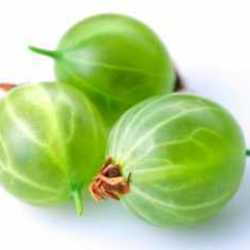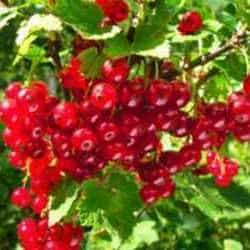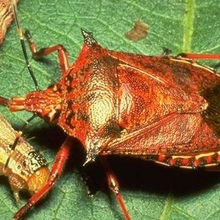An Ornamental Currant that Vines
by Larry Rettig May 10, 2010
With edible landscaping becoming more popular, it's time to get acquainted with the Clove Currant Vine. Not only does it have clusters of beautiful yellow flowers tinged frequently with red centers (see photo below), it is also fragrant (as its name implies) and bears edible fruit. In fall its leaves turn a bright golden with red highlights. Even if you don't grow this plant for its edibility, it puts on such a show and is so fragrant that it deserves a special place in your garden.
urrants (
Ribes odorata) that vine are somewhat unusual and, as far as I can tell, rather rare. The currants with which many of us are familiar grow on bushes and bear red, white, or black berries. Growing up in a German settlement in eastern Iowa, I became acquainted with a vining variety, which is said to have been brought from Germany to the U.S. by the settlers of our villages back in the mid-1800s. They were and still are grown on large trellises that support vines as long as 10 to 12 feet.
 |
Clove Currant Vine in an Iowa village settled
by German immigrants |
 |
Clove Currant 'Crandall' espaliered on author's
fence |
Back in Germany, these vining currants were often grown in vineyards and used to flavor wines. The vines become woody with age and, like grapes, can be trained to grow horizontally along wires. When grown on a trellis, the vines may need to be tied to it occasionally. Unlike grapes, they don't have tendrils with which to attach themselves to a support.
I've searched long and hard to find a source for the European vining cultivar, but have come up empty-handed. My next move was to find a readily available variety that I might be able to train as a vine, so that I could recommend it to fellow gardeners who, in turn, would be able to appreciate this wonderful vine as I have. I'm happy to say that I found one! High Country Gardens sells a native black currant, Ribes odoratum, 'Crandall'. I ordered a plant two years ago that was about a foot tall when I planted it. Lacking an arbor, I decided to espalier it on a picket fence. The longest vine already measures over six feet and has put out eight inches of new growth so far this spring.
If you're a gardener who likes oo's and ah's from visitors to your garden--and what gardener doesn't--this vine is a must-have.
Please note: After publication of this article, I became aware that planting black currants may be illegal in some states (http://urbanext.illinois.edu/ShrubSelector/detail_plant.cfm?PlantID=431). Please check with the appropriate extension office in your state to make sure you can plant Ribes odoratum.
At a Glance
| | Hardiness | Zones 4-8 | | Soil | Any, except hard clay | | Light | Full sun, part sun | | Moisture | Will adapt | | Vine length | 10-12+ feet | | Foliage | Deciduous, red and yellow in fall | | Flowers | Yellow with red center, fragrant | | Bloom time | Spring | | Fruit | Edible, showy
black berries ripen
in fall | | Attracts | Birds, butterflies | | Tolerances | Deer, drought | | Maintenance | Low | | Propagation | Hardwood cuttings in
winter |
Questions? Comments? Please use the form below. I enjoy hearing from my readers! |
Black Currant Jam
1.5 pounds black currants
1.5 pounds sugar
1.5 pints of water
1 small plate, refrigerated Remove all the stalks from the currants and put in a large, deep saucepan. Add the water. Bring to a boil and then simmer for 30 minutes.
Lower the heat and add sugar, stirring until all the sugar has dissolved.
Bring to a rapid boil and boil for about 8 to 10 minutes.
Check for doneness by spooning a small amount onto the cold plate and leave it to cool briefly. Push the edge of the jam in with your finger. If the surface wrinkles it is ready. If not, leave to boil for a minute or two longer.
When ready, remove from the heat and skim off any foam on the surface. Leave to cool for 5 or 10 minutes before pouring into sterilized jam jars. Seal immediately and leave to cool completely before attaching labels. This recipe makes approximately 4 small jars of jam. |
© Larry Rettig 2010



















